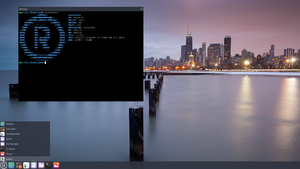Redox is a Unix-like operating system for x86 computers, based on a microkernel design. It is community-developed, released as free and open-source software and distributed under an MIT License. Written in the programming language Rust, Redox aims to be a general-purpose operating system that is safe and reliable. It is currently in a pre-stable status.
 | |
 Redox running Ion shell in Orbital windowing system | |
| Developer | Jeremy Soller, Redox Developers[1] |
|---|---|
| Written in | Rust, assembly |
| OS family | Unix-like |
| Working state | Current |
| Source model | Free software |
| Initial release | 20 April 2015 |
| Latest preview | 0.9.0 / 9 September 2024 |
| Repository | |
| Marketing target | Desktop, workstation, server |
| Available in | English |
| Package manager | pkgutils |
| Platforms | x86-64; ARM64 in development[2] |
| Kernel type | Microkernel |
| Userland | Custom |
| Influenced by | POSIX[3] |
| Default user interface | Command-line, Orbital |
| License | MIT |
| Official website | www |
Development
editRedox was created by Jeremy Soller and was first published on 20 April 2015 on GitHub.[4] Redox gets its name from the reduction-oxidation reactions in chemistry; one redox reaction is the corrosion of iron, also called rust. Soller himself is also an engineer at System76.[5]
Redox has a focus on safety, stability, and performance.[6][7][8] It is inspired by prior kernels and operating systems, such as SeL4, MINIX, Plan 9, BSD, and Linux.[citation needed] It runs on both 64-bit and 32-bit x86 processors, while a 64-bit ARM version is still at the preliminary stage.[9]
As of September 2024, the Redox repository had a total of 97 contributors.[10] The OS is not yet stable.[11]
Components and apps
editRedox provides packages (memory allocator, file system, display manager, core utilities, etc.) that together make up a functional operating system. Redox relies on an ecosystem of software written in Rust by members of the project. These include the Redox kernel, the Ralloc memory allocater, and the RedoxFS file system which is inspired by the ZFS file system.[citation needed]
pkgutils is Redox's package manager, while relibc is the C standard library. It has a display and window manager named Orbital, which manages the display, and handles requests for window creation, redraws, and event polling. The Ion shell are the underlying library for shells and command execution in Redox.[citation needed]
Redox includes a command-line interface (CLI) text editor similar to vi, called Sodium. There are numerous graphical user interface (GUI) applications preloaded including a web browser (NetSurf) that uses its own layout engine, a file manager (File Browser), an ANSI type terminal emulator (Orbterm), and various other tools like a software calculator and text editor.
See also
editReferences
edit- ^ "Redox Contributors". GitLab. Retrieved 24 March 2019.
- ^ "Porting Redox to ARM (AArch64)". 6 August 2018.
- ^ "What is Redox?". Archived from the original on 24 May 2020. Retrieved 16 May 2020.
- ^ Soller, Jeremy (jackpot51) (20 April 2015). "Initial commit of Rustboot-based OS". GitHub. GitHub, Inc. Retrieved 17 January 2017.
{{cite web}}: CS1 maint: numeric names: authors list (link) - ^ https://www.theregister.com/2019/11/29/after_four_years_rusty_os_nearly_selfhosting/
- ^ "Redox - Your Next(Gen) OS - Redox - Your Next(Gen) OS". www.redox-os.org.
- ^ Weisinger, Dick (4 May 2016). "Operating Systems: Rust Redox – An Next-Generation Attempt to Plug Linux OS Gaps". Formtek. Formtek, Inc. Retrieved 17 January 2017.
- ^ . Yegulalp, Serdar (21 March 2016). "Rust's Redox OS could show Linux a few new tricks". InfoWorld. San Francisco: IDG Communications, Inc. Retrieved 17 January 2017.
- ^ https://www.theregister.com/2022/11/29/redox_os_version_08/
- ^ "Redox Repository". GitHub. Retrieved 2016-03-26.
- ^ "Redox OS is the fastest Linux distro I've tested, and you should try it despite what it's missing". ZDNET. Retrieved 2024-12-13.